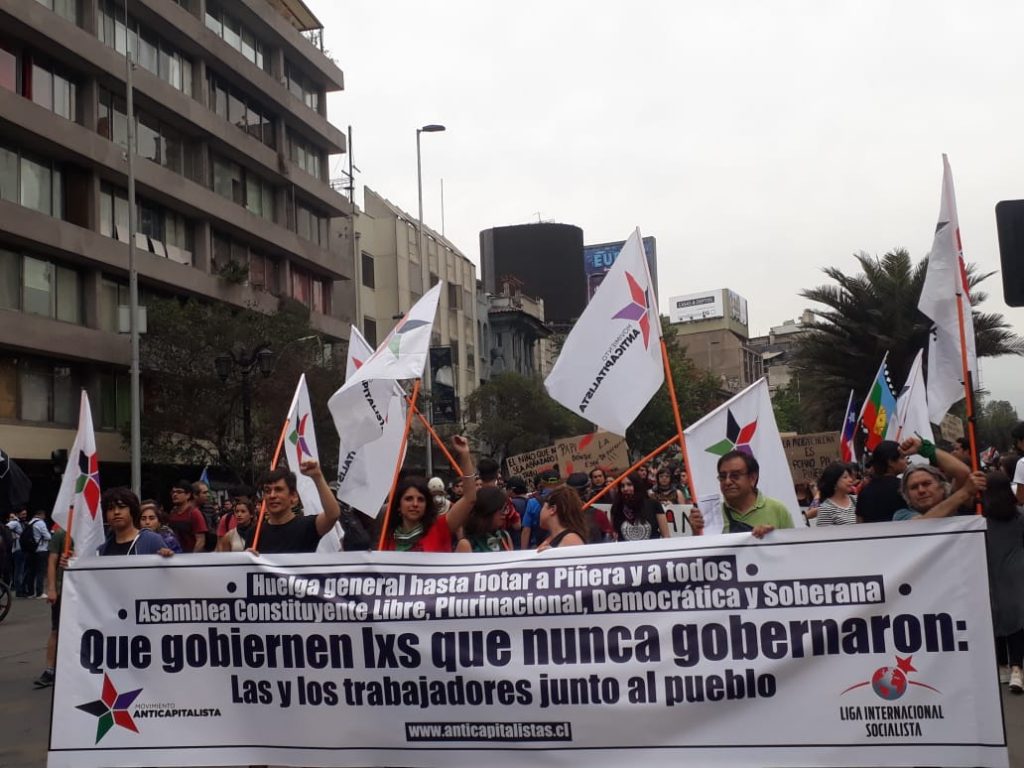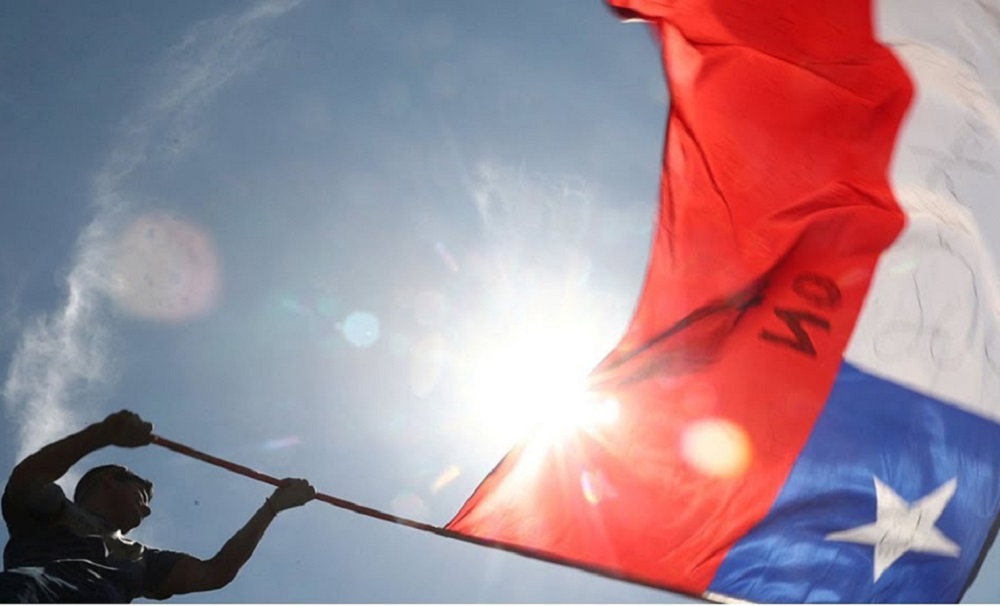Chile conmueve, emociona. El proceso social y político en curso es una verdadera revancha latinoamericana, mundial. Siempre creímos en las reservas acumuladas de ese pueblo, de su juventud, de su clase obrera. Siempre reivindicamos la revolución de 1970-73 y combatimos la criminal ideología de «la vía pacífica» al socialismo. Odiamos como a ninguna dictadura al pinochetismo. Por eso esta revancha es internacionalista. Una nueva etapa política en el país. Final incierto, dinámica apasionante.
Hay mucho de perfume a Mayo Francés. Como toda acción semi-espontánea de revuelta, las masas dominan el espacio público y multiplican mensajes, creatividad, potencia. Solamente para registrar los graffitis haría falta todo un libro. «Chile despertó»; «Tiembla la injusticia cuando luchas contra los que no tienen nada que perder»; «Pacos asesinos»; «Si la revolución es necesaria, la revolución es posible». Y las más repetidas: «Fuera Piñera» y «Nueva Constitución». Desde el 18 de octubre que Chile cambió, es otra cosa.
Está en estado casi de parálisis económica. Las calles despliegan una geografía de lucha de clases, intensa: hay huellas de incendios, de barricadas, de rabia popular que se repite en tres momentos del día, todos los días hace ya casi un mes. Desde la mañana, marchas, concentraciones, cortes de calles. A la tarde, siempre en Santiago movilización a Plaza Italia y por La Alameda ida y vuelta hasta La Moneda. Y como una postal cotidiana, asumida, represión con gases, agua y balas de goma. El repliegue hacia la periferia es recibido por cacerolazos y a la noche, ya tarde, piquetes y barricadas. Y enfrentamiento con los «pacos»: los carabineros. Así, incansablemente. Y así en todo el país. Desde Arica hasta Punta Arenas. Si se camina el centro de Santiago, los edificios hablan: afiches escritos a mano con resoluciones de cabildos, asambleas, reuniones. Los semáforos no funcionan. El transporte, poco. Las principales cadenas de supermercados y los emblemas del consumismo privilegiado capitalista, saqueados, quemados. La revancha de masas. Treinta años desatados. Conmueve. Emociona.

El régimen, sobrepasado
El capitalismo en Chile está montado sobre una dura derrota. La violencia genocida que la burguesía y el imperialismo usaron con Pinochet fue proporcional al volumen político de la fuerza oponente que enfrentó. Los cordones industriales como forma embrionaria de poder obrero; las juntas de abastecimiento como mecanismo de control social contra el mercado, la especulación y el lock out patronal. El rol del Partido Socialista de Allende en tándem con el PC apostando a la conciliación de clases y la vía parlamentaria al socialismo, y el MIR con acciones descolgadas y a la vez alternativizando a los cordones reales de la clase obrera, «comandos comunales» inventados por ese aparato ultraizquierdista. Sobró fuerza, pero a la clase obrera le faltó dirección revolucionaria. Para desmantelar ese andamiaje de revolución en curso, el fascismo mostró toda su brutalidad clasista. La salida de la dictadura 1989, pactada con el PS, la Democracia Cristiana y el PC, sentó las bases del régimen político hoy acorralado, que incluye un antidemocrático “tribunal constitucional” por encima del Parlamento. El mismo tuvo como fundamento garantizar impunidad a los genocidas y los pilares básicos del capitalismo brutal: privatización de las jubilaciones; mercantilización de la educación y la salud; precariedad laboral; desarticulación sindical y una democracia burguesa limitada, bajo la tutela represiva de un aparato policial-militar y de espionaje siniestro. La alternancia entre la Concertación (PS-DC), con apoyo del PC y la derecha de herencia pinochetista, administró con consensos básicos el poder burgués en Chile hasta ahora. La acumulación de contradicciones tuvo hitos hasta llegar al estallido actual: en 2006 y 2011, la juventud como protagonista contra el negocio de la educación. En 2018, el movimiento No + AFP contra las jubilaciones privadas. Este año, la enorme huelga del movimiento de mujeres. Antes, las protestas del pueblo mapuche contra la militarización de su territorio, el despojo y los crímenes. Claro, hubo otras luchas, pero los puntos de inflexión los marcaron los jóvenes, las mujeres, los trabajadores y el pueblo mapuche. Ahora, toda la soberbia autoritaria de ese régimen está total y completamente desbordada por la confluencia objetiva de todos esos reclamos en un programa único que se sintetiza en la consigna que levanta el movimiento en las calles: «Nueva Constitución».
Poder dual no institucionalizado
Un dato saliente del proceso en Chile es que no hay figuras emergentes que sean emblemáticas. Luchas como las del 2011-2012 catapultaron dirigentes como Camila Vallejo (hoy diputada del PC) o sus relevos «renovadores» como Gabriel Boric o Giorgio Jackson, hoy diputados y dirigentes del Frente Amplio (FA). La revuelta actual no visibiliza liderazgos. Es popular, aunque con una intervención organizada de la clase obrera en dos impactantes huelgas generales -la última se está desarrollando mientras escribimos este artículo-con carácter nacional y un componente activo de la clase media urbana y los pobladores de las zonas populares. El liderazgo es la acción independiente del movimiento de masas que sacude todo. A la vez, como todo fenómeno de revolución que inicia, al prolongarse en el tiempo sin desenlace, da fenómenos de autoorganización, incipientes, embrionarios, pero que marcan tendencias:
Asambleas barriales: en todo el país. Decenas y decenas en Santiago.
- Cabildos: como forma organizativa que promovida desde arriba por el PC y el FA, sin embargo, terminan desbordadas y en lugar de ser «comisiones de debate temático» fragmentadas, derivan en asambleas populares. Como en las asambleas, predomina el componente juvenil.
- Comités de huelga territoriales: todavía incipientes, pero que evidentemente reflejan grietas en la burocracia sindical de la CUT -hegemonizada por el PC- y desenvuelve la acción de potentes organizaciones como la Unión Portuaria, que encabezó en regiones y comunas, esos organismos que prepararon la huelga del 12 de noviembre. Son en tensión con el Comité de Huelga nacional, controlado desde arriba por el PC y la CUT.
- Coordinadoras de asambleas y cabildos: tuvimos oportunidad de participar llevando nuestro saludo internacionalista y acompañando a nuestros compañeros del Movimiento Anticapitalista de Chile, de la Coordinadora de Puente Alto, al sur de Santiago. Ese organismo nucleó representantes de asambleas y cabildos de la zona. También funciona una Asamblea de Asambleas Metropolitana, cerca de la Villa Olímpica, también con decenas de instancias de base representadas.
Todas esas expresiones son embrionarias, no consolidadas y con una perspectiva errática todavía, por la orientación de las fuerzas que actúan (lo desarrollamos aparte). Pero, de conjunto, en las calles existe un verdadero «doble poder» sin institucionalizar. Es una enorme experiencia deliberativa, de politización y prueba de líneas distintas entre las direcciones que están haciendo miles y miles de jóvenes, trabajadores y sectores populares en la revolución chilena.
Anticapitalismo, socialismo y consciencia
La protesta semi-insurreccional en Chile está motorizada por un conjunto de demandas, de causas que se fueron expresando de forma parcial y que ahora se unifican en un solo movimiento de masas. Es decir: objetivamente la revolución tiene un programa. Las banderas son:
- Contra las AFP, sistema jubilatorio solidario de reparto.
- No más precarización laboral, y salario acorde a la canasta real.
- Educación pública, gratuita, universal y condonación de deudas.
- Aborto legal, seguro y gratuito. Emergencia en violencia de género. Educación Sexual Integral. Contra toda forma de desigualdad laboral por razones de género.
- Contra el saqueo y depredación de la megaminería, y las forestales.
- Juicio y castigo a los genocidas de la dictadura y los crímenes de los últimos 30 años.
- Repudio al sistema político de privilegios y la justicia del régimen.
Estas son las más sentidas por el conjunto. Las que surgen en cualquier diálogo elemental en la calle. Las respuestas a estos reclamos tienen todas un carácter común: cuestionan los pilares del capitalismo chileno y el régimen de la democracia burguesa tutelada por los herederos del pinochetismo. Implican nacionalizar el sistema financiero y asegurar con ese patrimonio un sistema jubilatorio solidario; implica leyes laborales contra la precarización que cuestionan la explotación patronal; suponen confrontar el lobby clerical y eliminar todo subsidio a las iglesias; implica desmantelar el aparato de represión y espionaje; plantea construir una comisión investigadora independiente para los crímenes de la dictadura. Es decir: es objetivamente un movimiento revolucionario anticapitalista -por las demandas que plantea- pero que no tiene una conducción política mayoritaria que levante ese programa y un método de huelga general y autoorganización revolucionaria para conquistarlas a través de un gobierno obrero y popular. Por eso la definimos como «inconscientemente socialista» y la tarea, entonces, es darle perspectiva consciente. Esto significa poner en pie una organización política que tenga un programa y orientación en sintonía con las causas movilizadoras de las masas. Ese es el desafío planteado. Esa es la enorme contradicción de la revolución chilena.
Mariano Rosa, Enviado especial a Santiago de Chile
Leer también: Chile: polémicas y fueras en disputa
La LIS, el Movimiento Anticapitalista de Chile y el MST
El capital es mundial, internacional. Su lógica de explotación y despojo, también. Esta simple afirmación es la base de nuestra militancia y construcción internacionalista, para oponerle a las corporaciones y sus gobiernos nuestra resistencia obrera, juvenil y popular, con programa y organización revolucionaria. La Liga Internacionalista Socialista se construye a partir de la intervención concreta de sus partidos y grupos, en los procesos reales de lucha de clases. Realiza campañas de apoyo militante para fomentar la solidaridad activa, en la vanguardia de cada país, con las luchas y revoluciones de los pueblos del mundo, y contribuir a formar partidos de cuadros para la revolución socialista. Chile, hoy, está en el centro de nuestra actividad internacional y a la vez, tiene a su joven organización nacional, el Movimiento Anticapitalista, actuando, creciendo y fogueándose en un proceso apasionante, decisivo para la revolución en América Latina. Luchando en asambleas, cabildos, marchas y barricadas por el conjunto de las ideas que levantamos en cada país y en todo el mundo: que se vayan los gobiernos burgueses con la huelga general, impulsar procesos constituyentes libres y soberanos que reorganicen los países sobre bases socialistas y realmente democráticas, preparando gobiernos de los que nunca gobernamos: los trabajadores y el pueblo.
La LIS está desplegando una campaña de solidaridad por Chile en sus distintas secciones nacionales. A la vez, apoya con el MST de Argentina desde hace semanas la actividad del Movimiento Anticapitalista. Una de sus principales figuras nacionales, Cele Fierro, participó hace días de asambleas de mujeres, de movilizaciones, charlas en universidades y reuniones con la militancia y el activismo del Movimiento Anticapitalista. A su vez, Mariano Rosa, de la dirección nacional del MST en equipo con la coordinación de la LIS, colabora en tareas de propaganda y organización también en Chile, llevando el saludo internacionalista del partido argentino a asambleas y cabildos. En definitiva: internacionalismo militante, activo, práctico, de intervención en la lucha de clases para construir partidos nacionales como parte de una organización revolucionaria internacional.
M.R.




